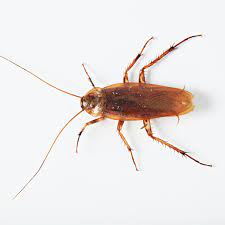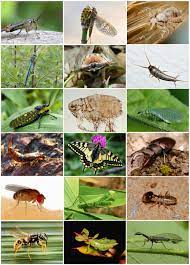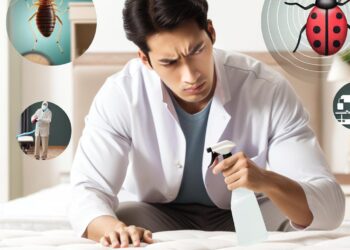Introduction:
Pests are a common problem for homeowners and can cause damage to both property and health. Identifying different types of pests is crucial in determining the best method for eradicating them. In this guide, we will explore the physical characteristics and Behaviour of common household pests to help you spot and stop them in their tracks.
- Ants: Ants are social insects that live in colonies. They have a narrow waist and three body parts, with antennae on their heads. Some ants can bite or sting, but most are harmless. They are attracted to sweet foods and can be found crawling in lines or clusters.

- Bed Bugs: Bed bugs are small, reddish-brown insects that feed on human blood. They are oval-shaped and flat, with no wings. Bed bugs are attracted to warm-blooded hosts and can cause itchy bites. They are often found in mattresses, furniture, and bedding.
- Cockroaches: Cockroaches are brown or black insects with flat, oval bodies and long antennae. They are fast-moving and can be found in dark, damp areas such as kitchens and bathrooms. Cockroaches are attracted to food and can spread disease.

- Fleas: Fleas are small, wingless insects that feed on the blood of animals and humans. They have flat bodies and are reddish-brown in color. Fleas can jump long distances and can cause itchy bites. They are often found in pet bedding and carpets.
- Mice: Mice are small rodents with pointed snouts and large, floppy ears. They have brown or grey fur and long, thin tails. Mice are attracted to food and can spread disease. They can be found in walls, attics, and basements.

- Rats: Rats are larger than mice and have longer, thicker tails. They have pointed snouts and small, round ears. Rats are attracted to food and can spread disease. They can be found in walls, attics, and basements. Spiders: Spiders are arachnids with two main body parts and eight legs. They come in various colors and sizes, and some can be venomous. Spiders are attracted to insects and can be found in corners, ceilings, and other secluded areas of the home.
- Termites: Termites are small, white or brown insects with soft bodies and straight antennae. They feed on wood and can cause severe damage to wooden structures in the home. Termites can be found in damp areas and are often mistaken for ants.

- Wasps: Wasps are stinging insects with long, slender bodies and two pairs of wings. They come in various colours, including yellow and black, and are attracted to sweet foods. Wasps can build nests in trees, bushes, and even inside the home.
- Silverfish: Silverfish are small, wingless insects with silvery-grey scales on their bodies. They are attracted to starchy materials and can be found in pantries, bookcases, and other areas with paper or fabric. Silverfish can be difficult to spot as they are fast-moving and nocturnal.
Prevention and Treatment:
Preventing pests from entering the home is key to avoiding infestations. Some prevention measures include:
- Keeping the home clean and free of food debris
- Sealing cracks and crevices in walls and floors
- Storing food in sealed containers
- Fixing leaks and reducing moisture levels in the home
- Properly disposing of garbage and compost
If you do have a pest problem, there are various treatment options available, depending on the type of pest and severity of the infestation. Some treatments include:
-
- Insecticides and baits
- Traps and repellents
- Fumigation
- Biological control (introducing natural predators to control pest populations)’

It is also important to note that some pests, such as termites and bed bugs, can be particularly difficult to eradicate on your own. In these cases, it is best to seek the help of a professional pest control service to ensure that the infestation is properly addressed.
Additionally, it is crucial to be aware of the potential health hazards that pests can pose. Some pests, such as cockroaches and mice, can spread disease and cause respiratory problems, while others, such as wasps and bees, can be dangerous to those with allergies. If you are experiencing any symptoms related to a pest infestation, it is important to seek medical attention right away.
In addition to the measures discussed in the previous section, there are some other steps that homeowners can take to help prevent pest infestations. These include:
- Properly storing and disposing of waste: Garbage and compost should be stored in sealed containers, and bins should be emptied regularly to avoid attracting pests. It is also important to ensure that trash cans are kept away from the home’s exterior and that any potential entry points, such as gaps in the lid or holes in the container, are sealed.
- Sealing entry points: Sealing up gaps and cracks in the home’s exterior can help prevent pests from entering. This includes sealing up gaps around doors and windows, as well as any openings around pipes, vents, and utility lines. For larger gaps, expanding foam or caulking can be used, while smaller gaps can be filled with weather stripping or mesh.
- Properly maintaining the home’s exterior: Regularly trimming back bushes and trees and keeping the lawn mowed can help prevent pests from finding shelter near the home. It is also important to fix any exterior damage, such as holes in the roof or siding, as these can provide an entry point for pests.
- Keeping the home clean and clutter-free: Pests are attracted to food debris, so keeping the home clean and free of clutter can help prevent infestations. Regularly vacuuming carpets and upholstery, wiping down counters and floors, and storing food in sealed containers can all help reduce the likelihood of pests finding their way into the home.

By taking these measures, homeowners can help reduce the likelihood of a pest infestation in their homes. However, it is important to note that even with the best prevention measures, pests can still find their way into the home. If you suspect that you have a pest problem, it is best to contact a pest control professional to address the issue promptly.
Conclusion:
Identifying different types of pests is the first step in eradicating them from your home. By understanding their physical characteristics and Behaviour, you can take the appropriate measures to prevent infestations and protect your property and health. Remember to contact a pest control professional if you are unsure of how to deal with a pest problem.















